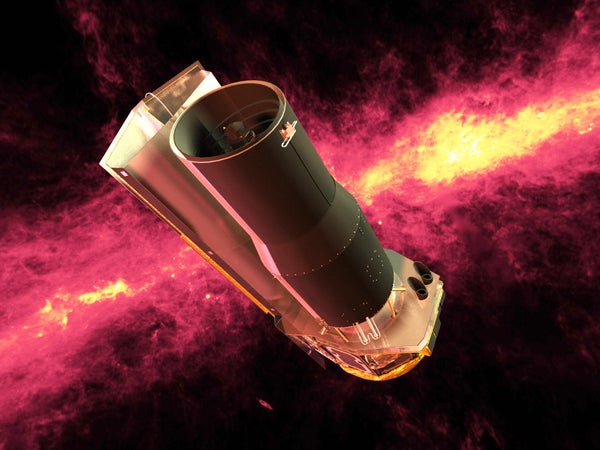This article was published in Scientific American’s former blog network and reflects the views of the author, not necessarily those of Scientific American
For more than 16 years, starting with its launch in 2003, the Spitzer Space Telescope, which will cease operations at the end of this month, has provided us with an unprecedented view of the universe at infrared wavelengths, invisible to the human eye. Spitzer’s explorations—as described in over 8,600 refereed papers, dozens of PhD theses, innumerable conference abstracts and talks and several books—range from determining the sizes of near-Earth asteroids to measuring the mass and age of the stars in the most distant galaxies. Spitzer has had a major impact in no fewer than five major areas of astronomical research:
Solar system studies. Highlights of Spitzer’s studies of our own Solar System include discovery of a huge, previously unknown dust ring orbiting Saturn and determination of the composition of the dust ejected from Comet Tempel I after the Deep Impact spacecraft sent a projectile to crash into it. These cometary measurements are one of many Spitzer results that established important connections between the properties of the Solar System and those of exoplanetary systems—which themselves have also been extensively studied by Spitzer.
The Formation of stars and planetary systems. Spitzer observations have shown that as a star forms, a significant amount of matter goes into the formation of a disk that orbits it. Spitzer has observed the first stages of planetary formation as the ultrafine cosmic dust within the disk begins to coalesce into larger bodies, initiating a cascade which frequently leads to the formation of planets. These early stages of planet formation are well underway just a few million years after the collapse of a dense interstellar cloud triggers the star formation process—a relative instant in cosmic terms.
On supporting science journalism
If you're enjoying this article, consider supporting our award-winning journalism by subscribing. By purchasing a subscription you are helping to ensure the future of impactful stories about the discoveries and ideas shaping our world today.
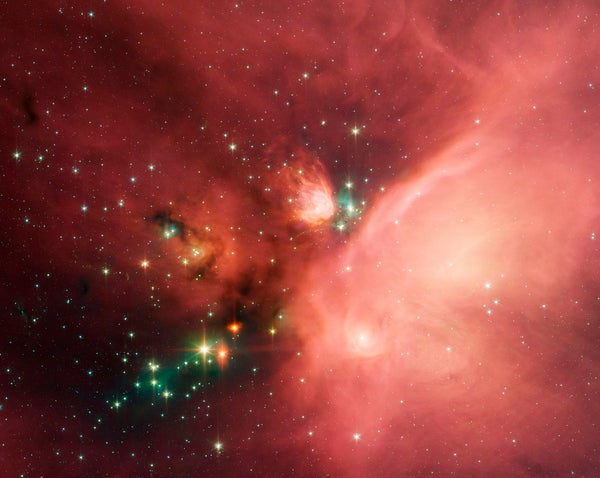
Spitzer image of star formation in the Rho Ophiuchi cloud. Credit: NASA, JPL-Caltech and Harvard-Smithsonian CfA Wikimedia
Exoplanets. Even as the Spitzer mission unfolded, studies from ground based telescopes and, most notably, from NASA’s Kepler spacecraft were establishing that many solar-type stars host planetary systems, which often include planets no more than twice the size of the Earth. Spitzer has become a pillar of the science community’s aggressive and insightful study of these exoplanets. Spitzer established that of three of seven Earth-sized planets orbiting the nearby faint red star known as Trappist-1 lie in or near the habitable zone—the region around the star where water would be liquid on the planets’ surface, which is believed to be essential for the formation of life as we know it.
Spitzer has also mapped the variation of a planet’s temperature around its circumference, finding evidence for atmospheric winds with velocities of thousands of kilometers per hour in several cases. It is amazing to me that Spitzer’s measurements allow me to write with some degree of certainty about the temperature distribution on the surface of a planet orbiting a star that lies some 65 light-years from Earth.
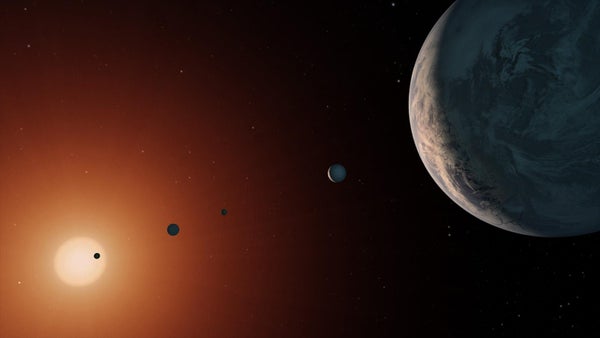
Artitst's rendering of the Trappist-1 solar system. Credit: NASA and JPL-Caltech
Distant galaxies. Spitzer has surveyed large sections of both the Milky Way galaxy and the universe beyond. One such survey, coordinated with the Hubble Space Telescope, led to the identification of the most distant galaxy found to date. Spitzer and Hubble see it as it was not long after the big bang, which occurred about 13.8 billion years ago. The existence of massive galaxies like this so early in the evolution of the universe challenges our understanding of how galaxies form, posing questions which will be addressed by NASA’s forthcoming James Webb Space Telescope, to be launched in 2021.
The growth of stars and galaxies. The universe emerged from the big bang as a hot soup of hydrogen and helium atoms, which helps us understand why galaxies such as that described above were few and far over 13.5 billion years ago. They are common today, however, which is due to the fact that the number of stars in the universe has increased over time as galaxies formed and grew and as more and more of the material they contained collapsed to form stars. Spitzer is uniquely able to measure this growth over cosmic time, finding that the number of stars grew rapidly for the first four billion years of the life of the universe but has increased at a slower rate more recently.
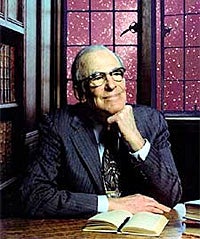
The late Lyman Spitzer.
Credit: NASA Wikimedia
As powerful as these scientific results are, however, they are but one portion of Spitzer’s legacy. Other areas where that legacy has been and will be of great importance include the following:
The Great Observatories. The Great Observatories concept, laid out in 1985 by NASA and the scientific community, envisioned four powerful space telescopes, covering the entire electromagnetic spectrum in wavelengths shorter than of radio waves, operating simultaneously. Spitzer, originally known as the Space Infrared Telescope Facility (SIRTF), was a charter member of this elite group, joining the Compton Gamma Ray Observatory, the Hubble Space Telescope and the Advanced X-Ray Astrophysics Facility (AXAF), now known as the Chandra X-Ray Observatory. The completion of the Great Observatories with the launch of SIRTF in 2003 is an undercelebrated milestone in the exploration of the universe, representing the realization of a vision some 20 years in the making. The synergistic science of these powerful observatories has had far greater impact than we could have been imagined when this program was formulated.
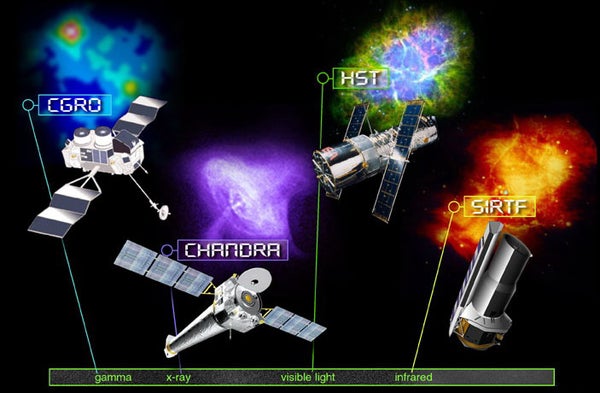
NASA's Great Observatories; SIRTF, on the far right, was renamed after the astrophysicist Lyman Spitzer, who was a longtime advocate of sending telescopes into space. Credit: NASAWikimedia
No mission is an island. Spitzer’s observations have enhanced the scientific return not only from other NASA missions but also from ground-based instruments. For example, Spitzer and Hubble have joined forces to determine the properties of the most distant known galaxies, and, much closer to home, have also strongly constrained the properties of exoplanet atmospheres. Spitzer is even now studying exoplanets identified by the recently launched Transiting Exoplanet Survey Satellite, in order to determine the temperatures of these newly discovered worlds. Finally, Spitzer has observed the aftermath of a remarkable neutron star coalescence event discovered by gravitational wave observatories and verified models for the synthesis of rare earth elements in the neutron rich debris of this cataclysmic event.
Setting the table for future missions.
NASA’s IRAS and the European Space Agency’s (ESA) ISO helped lay the ground work for Spitzer; Spitzer, in turn, is preparing the way for future NASA missions. Most notable among these, is the long-awaited James Webb Telescope (JWST), which will cover some of the same wavelengths studied by Spitzer but with much higher sensitivity and spectral and spatial resolution. Spitzer also is preparing the ground for other upcoming NASA missions, most notably Euclid (a joint mission with ESA) and Wide Field Infrared Survey Telescope (WFIRST). In both cases, Spitzer’s extensive extragalactic surveys will provide an infrared counterpart to the wide-field optical/near infrared surveys Euclid and WFIRST will conduct
Spitzer has also pioneered technological advances that prepare the way for future missions. Most notable among these is Spitzer’s extensive use of radiative cooling—radiating heat into the blackness of space—to achieve and maintain temperatures well below 50 kelvins, which previously were reached with the use of stored cryogens or mechanical coolers. Future missions, most notably JWST and also the SPHEREx Explorer now under development at JPL, can now establish a baseline for radiative cooling with a great deal more assurance and confidence than was previously possible.
Capturing the public imagination.
As is the case with many other NASA missions, the most exciting and accessible results from Spitzer have been widely disseminated to the public. Its most notable result, the analysis of the planets orbiting Trappist-1, spawned more than 17,000 print and online articles; the news conference announcing the result was viewed almost five million times, and the story received more than 3.2 billion nonunique views over the internet.
A major human achievement. There is a human side to Spitzer that merits special emphasis. Thousands of people worked on Spitzer prior to and following launch, preparing and maintaining this powerful observatory and facilitating its use by a large and vigorous community of astronomers. All of these people should feel pride in what they have accomplished, as the success of Spitzer is directly traceable to their skill, ingenuity and dedication. The technically complex and innovative Spitzer facility shows what a group of skilled and motivated people, properly supported and empowered, can accomplish. I feel that Spitzer is a monument to the power of the human spirit. We should be guided by this important component of Spitzer’s legacy, which applies in all areas of human endeavor, as we navigate the sea of problems which we face.
What’s next? The end of Spitzer’s observations this is not the end of Spitzer, as all data from the mission are archived and available from the IRSA facility at Caltech. Readers eager to learn more about Spitzer might want to take a look at the book I co-authored with Peter Eisenhardt: More Things in the Heavens: How Infrared Astronomy is Expanding our View of the Universe, published by Princeton University Press.
